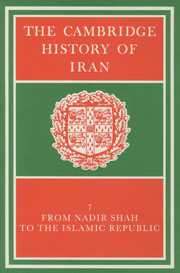Book contents
- Frontmatter
- PART 1 THE POLITICAL FRAMEWORK, 1722–1979
- 1 NĀDIR SHĀH AND THE AFSHARID LEGACY
- 2 THE ZAND DYNASTY
- 3 ĀGHĀ MUHAMMAD KHĀN AND THE ESTABLISHMENT OF THE QĀJĀR DYNASTY
- 4 IRAN DURING THE REIGNS OF FATH ‘Alī SHāH AND MUHAMMAD SHāH
- 5 IRAN UNDER THE LATER QĀJĀRS, 1848–1922
- 6 THE PAHLAVĪ AUTOCRACY: RIŻĀ SHĀH, 1921–41
- 7 THE PAHLAVĪ AUTOCRACY: MUHAMMAD RIŻĀ SHĀH, 1941–1979
- PART 2 FOREIGN RELATIONS
- PART 3 ECONOMIC AND SOCIAL DEVELOPMENTS
- PART 4 RELIGIOUS AND CULTURAL LIFE, 1721–1979
- Genealogical tables
- Bibliographies
- Index
- References
1 - NĀDIR SHĀH AND THE AFSHARID LEGACY
from PART 1 - THE POLITICAL FRAMEWORK, 1722–1979
Published online by Cambridge University Press: 28 March 2008
- Frontmatter
- PART 1 THE POLITICAL FRAMEWORK, 1722–1979
- 1 NĀDIR SHĀH AND THE AFSHARID LEGACY
- 2 THE ZAND DYNASTY
- 3 ĀGHĀ MUHAMMAD KHĀN AND THE ESTABLISHMENT OF THE QĀJĀR DYNASTY
- 4 IRAN DURING THE REIGNS OF FATH ‘Alī SHāH AND MUHAMMAD SHāH
- 5 IRAN UNDER THE LATER QĀJĀRS, 1848–1922
- 6 THE PAHLAVĪ AUTOCRACY: RIŻĀ SHĀH, 1921–41
- 7 THE PAHLAVĪ AUTOCRACY: MUHAMMAD RIŻĀ SHĀH, 1941–1979
- PART 2 FOREIGN RELATIONS
- PART 3 ECONOMIC AND SOCIAL DEVELOPMENTS
- PART 4 RELIGIOUS AND CULTURAL LIFE, 1721–1979
- Genealogical tables
- Bibliographies
- Index
- References
Summary
ORIGINS AND FRONTIER EXPERIENCES
The year 1688 has recently found acceptance as that of Nādir's birth, but one of the best Iranian authorities for his time, the Jahān-gushā-yi Nādirī of Mīrzā Mahdī Khān Astarābādī, spells out a.h. 1110 as the year, and 28 Muharram as the day, which gives us 6 August A.D. 1698. A Bombay lithographed edition of Mīrzā Mahdī Khān's Jahān-gushā has a.h. 1100, but this date is not supported by manuscripts and the Tehran edition of the early nineteen sixties prefers the 1110 a.h. date. Other dates are given in other sources and are discussed by Dr Lockhart in his Nadir Shah, but it so happens that another contemporary source, the ‘Ālam-ārā-yi Nādirī of Muhammad Kāzim, the “Vazīr of Marv”, gives a.h. 1109 as the year of conception and, although he does not give the precise date of birth, this date corroborates 1110 as the year of delivery. It took place in the Darra Gaz, where a first-born and for some time only son was brought into the world for Imām Qulī, Nādir's father, in the fortress at Dastgird, a refuge for Nādir's people against the border raids from which the northern Khurāsān uplands frequently suffered.
Dastgird was in the winter quarters, where Nādir's father might have lingered on account of the expected birth. The summer-grazing was near Kupkān or Kubkān, thirty-eight kilometres southwest of the Dastgird-Chāpshalā winter-grounds in the low-lying, milder Darra Gaz, “Valley of Manna”. Further to the east, on the margin of the Marv desert, lay Abīvard, the metropolis of this region and in Nādir's youth the seat of the Safavid agent or district governor.
- Type
- Chapter
- Information
- The Cambridge History of Iran , pp. 1 - 62Publisher: Cambridge University PressPrint publication year: 1991
References
- 3
- Cited by

